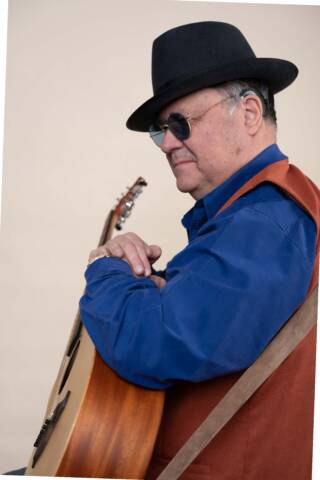
I (Tarja Rautiainen-Keskustalo) had the privilege of interviewing Russ Palmer about his groundbreaking work on sound and vibration. Our conversation delved into the possibilities of understanding different ways of sensing, offering a unique perspective on his research and its implications.
Congratulations for the Honorary Doctorate! What are your feelings?
I am getting geared up to the process of what’s going to happen because it is a big thing for me – I’ve never dreamt anything like that.
How would you reflect your career as a deafblind music therapist; what kind of efforts has been needed to achieve this nomination?
I have always been a very stubborn person. I have thought that if one thing doesn’t work, you try something else. Also, my parents encouraged me to have the tenacity to continue and to have ambition despite Usher Syndrome. All these many changes in my life have been reasons to examine sensing and gaining information from the world in different ways.
Vibrosensoric approach
During his career, Palmer has written academic articles and done a lot of voluntary work among deafblind people, encouraging them to express themselves. One of the most important methods he has developed is a vibrosensoric method. It highlights how complex issues sound is; quite often we think it is a relatively unproblematic practice, something we do with our ears, but the vibrosensoric approach highlights how sound is also a tactile phenomenon; we “hear” through our bodies.
What was a starting point for this approach?
At the beginning of the 1990s, I had contact with deaf schools in Helsinki and Oulu, and teachers there were interested in my idea of how you feel musical vibrations through your body, how to appreciate a specific “feel” of music, for example, how you can feel instruments through your hands. This kind of sensing often includes visual information, such as seeing how other people move when playing instruments during a performance. In other words, the method highlights a human being’s multisensoriality and has many connections to so-called social-haptic communication. This, in turn, encourages us to widen our understanding of sound and music. I want to emphasize that I am not teaching music in a way that people with “normal” hearing and seeing understand the concept but examine different ways to express and feel the music through tones. This is a very culturally sensitive issue for people with sensory impairments – and that’s what I initially wanted to do with this approach. For example, Signmark, a deaf rap artist who has participated in my course early 1990´s, later came to me and thanked me for ideas and encouragement. He has argued that sign language should be treated as a language minority, not highlighting impairment.
Technologies, different kind of hearing aids, is essential part of you daily life. How has it changed the listening?
I have been totally blind since 2014, but I can hear by using two cochlear implants, and that’s the reason I can continue to make and listen to music. Actually, I have changed my sensory world; before total blindness, I was pretty visual; now, I have turned to sound. Implants have made me reflective and sensitive to the different qualities of sound, and that’s very important and beneficial for my singing and music-making in general. However, digitalization has not always meant development as such; sometimes, I have noticed how adjusting the sound qualities was better in the times of analogue technologies; digital sound sometimes narrows down the richness of the sound world; it has been compressed too much.
Nowadays, we talk a lot about society’s accessibility, and many efforts have been made in that direction. However, sometimes, the obstacle is that understanding the lives of people with sensory impairments is still very limited—a perspective at the grassroots level is missing. What would you suggest if someone wants to understand the lives of deafblind people?
I think the best starting point is to try to get down to the same level as a person with impairment and explore what it’s like to be there; in other words, one way could be to use some simulation, then go, for example, to some building and try to find doors, info, WC, and recognize how difficult it is to move around… Getting into the world takes time; it is not just one short period of time, but hopefully, you can spend hours, days or even weeks experiencing the world from a different perspective; all these hidden things you are not aware of.
The Doctoral Conferment Ceremony takes place at the University of Oulu on 17–19 May 2024.
More information about Russ Palmer’s research and career: https://www.russpalmer.com/.
